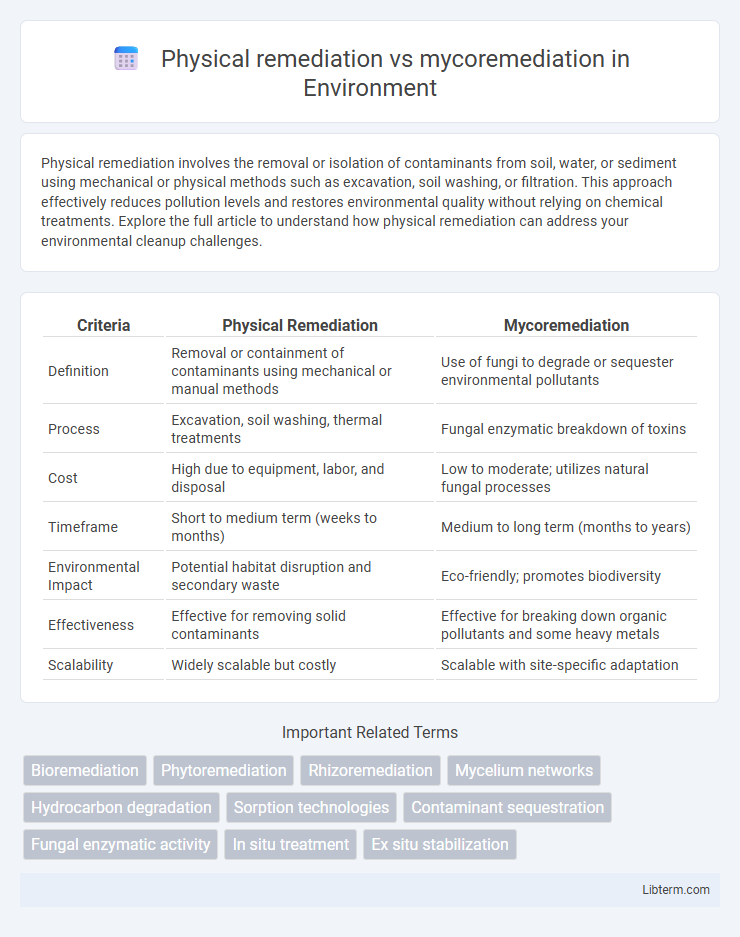Physical remediation involves the removal or isolation of contaminants from soil, water, or sediment using mechanical or physical methods such as excavation, soil washing, or filtration. This approach effectively reduces pollution levels and restores environmental quality without relying on chemical treatments. Explore the full article to understand how physical remediation can address your environmental cleanup challenges.
Table of Comparison
| Criteria | Physical Remediation | Mycoremediation |
|---|---|---|
| Definition | Removal or containment of contaminants using mechanical or manual methods | Use of fungi to degrade or sequester environmental pollutants |
| Process | Excavation, soil washing, thermal treatments | Fungal enzymatic breakdown of toxins |
| Cost | High due to equipment, labor, and disposal | Low to moderate; utilizes natural fungal processes |
| Timeframe | Short to medium term (weeks to months) | Medium to long term (months to years) |
| Environmental Impact | Potential habitat disruption and secondary waste | Eco-friendly; promotes biodiversity |
| Effectiveness | Effective for removing solid contaminants | Effective for breaking down organic pollutants and some heavy metals |
| Scalability | Widely scalable but costly | Scalable with site-specific adaptation |
Introduction to Environmental Remediation
Physical remediation techniques involve the use of mechanical processes such as excavation, soil washing, and containment to remove or isolate contaminants from polluted sites. Mycoremediation utilizes fungi's natural enzymatic capabilities to break down hazardous substances like hydrocarbons, heavy metals, and pesticides into less toxic forms. Both methods are vital components of environmental remediation, providing effective solutions for restoring contaminated soil, water, and air ecosystems.
Defining Physical Remediation
Physical remediation involves the mechanical removal or containment of contaminants from soil, water, or air, often through excavation, filtration, or soil washing techniques. This method focuses on the immediate physical separation or stabilization of pollutants to prevent further environmental damage. Unlike mycoremediation, which utilizes fungi to biologically degrade contaminants, physical remediation relies on engineered processes to directly remove or isolate hazardous substances.
Understanding Mycoremediation
Mycoremediation employs fungi to break down or absorb environmental contaminants, leveraging fungal enzymes and mycelial networks for effective pollutant degradation, especially in heavy metals and hydrocarbons. Unlike physical remediation methods, which involve mechanical or chemical processes to remove or isolate contaminants, mycoremediation offers a sustainable, biologically driven solution that enhances soil health and ecosystem recovery. Research in mycoremediation highlights the role of species like white-rot fungi in synthesizing ligninolytic enzymes crucial for decomposing toxic compounds and restoring polluted habitats.
Key Differences Between Physical Remediation and Mycoremediation
Physical remediation involves mechanical or chemical processes such as soil excavation, filtration, or chemical treatment to remove contaminants, offering rapid results but often at higher costs and environmental disruption. Mycoremediation uses fungi to naturally degrade organic pollutants through enzymatic action, promoting sustainable, eco-friendly cleanup with lower energy input but slower remediation rates. Key differences include the use of biological agents in mycoremediation versus physical means in traditional methods, cost-effectiveness linked to operational complexity, and long-term environmental impact.
Mechanisms of Pollutant Removal in Physical Remediation
Physical remediation primarily removes pollutants through mechanical processes such as filtration, sedimentation, and excavation, effectively isolating contaminants from the environment. Techniques like soil washing and air stripping physically separate or transfer pollutants without altering their chemical composition. These methods are highly efficient for removing heavy metals, hydrocarbons, and particulate matter but do not biodegrade contaminants like biological approaches.
Fungal Processes Involved in Mycoremediation
Mycoremediation employs fungal enzymes such as lignin peroxidase, manganese peroxidase, and laccase to break down complex pollutants into non-toxic compounds, distinguishing it from physical remediation methods that rely on mechanical removal or containment. Fungal mycelium penetrates contaminated substrates, secreting oxidative enzymes that degrade hydrocarbons, heavy metals, and pesticides through biotransformation and bioaccumulation processes. This biological approach enhances pollutant bioavailability and mineralization, promoting sustainable soil and water restoration compared to conventional physical remediation techniques.
Advantages and Limitations of Physical Remediation
Physical remediation offers the advantage of immediate removal or containment of contaminants, making it highly effective for emergencies and areas requiring rapid intervention. Its limitations include high operational costs, potential disruption to ecosystems, and the inability to address contaminants deeply embedded in soil or groundwater. Unlike mycoremediation, which uses fungi to naturally break down pollutants over time, physical methods often lack sustainability and long-term pollutant degradation.
Benefits and Challenges of Mycoremediation
Mycoremediation offers eco-friendly benefits by utilizing fungi's natural ability to break down contaminants like hydrocarbons and heavy metals, enhancing soil health and biodiversity. Challenges include the requirement for specific environmental conditions, longer treatment durations compared to physical remediation, and limited scalability in highly contaminated or heterogeneous sites. Unlike physical remediation, which often involves excavation and disposal, mycoremediation promotes sustainable pollutant degradation but demands careful monitoring to optimize fungal growth and efficacy.
Comparative Cost and Sustainability Analysis
Physical remediation techniques, such as soil excavation and containment, often involve high operational costs due to heavy machinery, labor, and waste disposal, whereas mycoremediation leverages fungi's natural enzymatic processes, significantly reducing expenses and energy consumption. Mycoremediation offers enhanced sustainability by promoting soil regeneration and minimizing chemical usage, contrasting with physical methods that may disrupt ecosystems and generate large volumes of non-recoverable waste. Cost-benefit analyses reveal mycoremediation as a more economically viable and ecologically sound approach for long-term contamination management, especially in organic pollutant degradation.
Choosing the Right Remediation Approach
Choosing the right remediation approach depends on site-specific factors such as contamination type, extent, and environmental impact. Physical remediation techniques, including excavation and soil washing, offer rapid contaminant removal but can be costly and disruptive. Mycoremediation leverages fungi to biodegrade pollutants sustainably, making it optimal for organic contaminants and long-term restoration with minimal environmental disturbance.
Physical remediation Infographic

 libterm.com
libterm.com